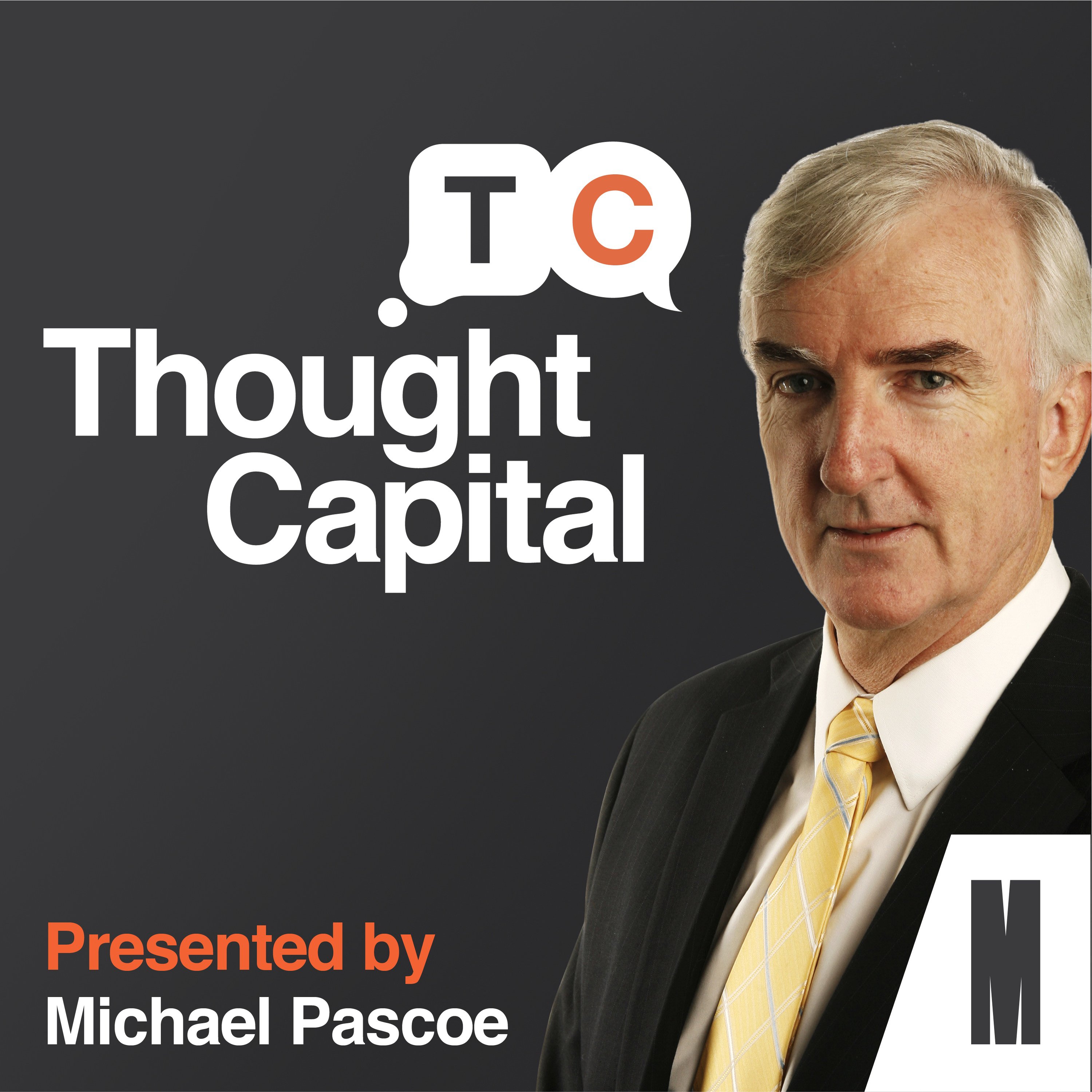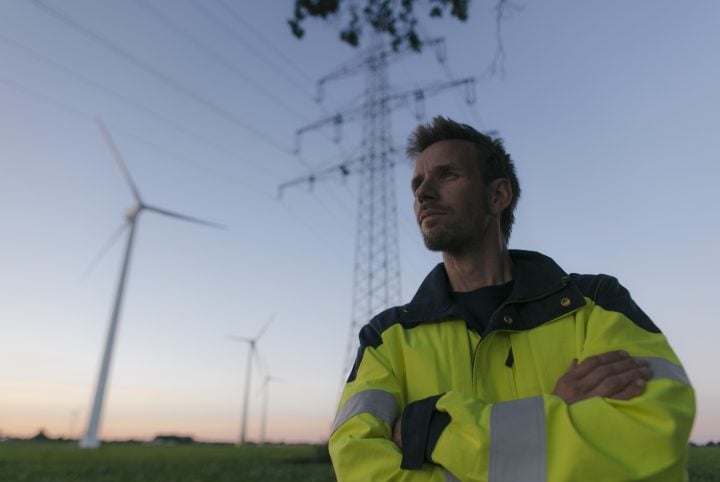Michael Pascoe: When it comes to the economy, everything is connected. Which is why this season, the Thought Capital will try to connect the dots on the impact of COVID-19. Just recording this podcast for Monash Business School is an example of the way the insidious coronavirus has changed our world.
Previously, I’d fly down to Melbourne from Sydney to record three or four interviews in a Monash studio and fly home for dinner. Or maybe stay in a hotel overnight for another batch of interviews the next day. This time, like many of you, I’ve been stuck in my home office, recording the interviews over Zoom.
The airline hasn’t had my business. Planes are grounded, staff let go. The hotel rooms have remained empty. The meals I would have purchased did not come into existence. The taxi or Uber rides untaken. We adapt. We still record the podcast.
The audio isn’t as fine but you’ve become used to that this year. You’ve adapted too. You understand the foibles and interruptions of working from home. And Zoom shares have soared, but the service sector, especially tourism and hospitality has taken a massive hit. All the businesses and people who used to get an indirect slice of the action from a Thought Capital podcast recording.
And the education sector certainly hasn’t been spared. From employment to its business structure, to the uncertainty over what to do next for work or study. In this episode, we are focusing on the state of our economy with the help of Professor Heather Anderson, from the Department of Econometrics and Business Statistics, and Professor Giovanni Caggiano from the Department of Economics at Monash Business School. Welcome.
Michael Pascoe: Heather, we call this episode, driving the Australian economy through a pandemic. What is the ride like?
Heather Anderson: Well, I suppose initially we were all subject to a very unexpected shock. The shock was stunning, and there’s been new shocks that come in as the virus has hit new countries and restrictions have been brought into place. But I think the characteristic that we’re now becoming more aware of is that this is going to go on for a long while. So there’s the marathon aspect of this ride that we have to start getting used to. And that’s actually, I think the hardest part of this.
Michael Pascoe: So the kids in the backseat screaming, “Are we there yet?” Are going to get short shrift.
Heather Anderson: Yeah, it was not just the kids. It’s the adults.
Michael Pascoe: Giovanni. How would you describe this ride?
Giovanni Caggiano: There’s a huge uncertainty about how the economy will go through this, what type of policies are the best policies to respond. Is there a trade off between the health crisis and the economic crisis? Is not clear whether or not relatively short pain of a lockdown is worth longer term gains. So it’s really like navigating the uncharted.
Michael Pascoe: Given the reactions, it’s hard for data to keep up to just where we are, let alone indicate where we might be going to. What are the figures telling us about the shape of this recession so far?
Heather Anderson: As far as where we are, the sectors that have been really hit are the arts and recreation, accommodation and food services, rental hiring. The initial statistics also showed a big drop in agriculture, but that was more due to the bush fires than to COVID itself. But the job numbers are already showing signs of improvement. Growth rates are showing signs of improvement in several sectors. And the predictions that we have done with our models suggests that if there aren’t more shocks and more waves then the growth rate will be back to where it was before by early 2022. The levels will take longer. How many jobs there are, that will take longer but we’ll return eventually. That’s what our predictions are saying.
Michael Pascoe: Giovanni, while employment picks up as the economy’s opened up again, we also have JobKeeper being wound back. JobSeeker supplements also wound back causing a rise in unemployment. The service sector has indeed caught the worst of it. Where do you see that going?
Giovanni Caggiano: There is one thing that is important here, which has also a longer term consequences. That is to keep labour participation up. Labour participation is important in the longer term because it affects what we call potential output. So you know, what the economy is able to produce when it is at full capacity, this shock is going to be temporary. How temporary? We don’t know yet. This is an economic shock that has a health origin. If you tackle the health crisis, you will tackle the economic crisis. Now, there’s a lapse of time. That goes from the start of the shock to the time where the shock will be over. It is important in this period of time, economic policy will keep workers into the labour force. And I think the JobSeeker and the JobKeeper programs going that direction.
Heather Anderson: We have done some analysis of the effects of JobKeeper. Certainly the growth rates have increased much more quickly than they would have if it was not there. We have that evidence there. We also see some evidence about whether JobKeeper would have the same effect if it was extended and that evidence was not there. In contrast, it would have some effect, but nowhere near as much as the first time.
Michael Pascoe: As they begin to get pulled back, is there going to be the demand? Where’s the demand coming from to take up the slack?
Giovanni Caggiano: Keeping up demand means giving people cash to spend. People need to have increase in their disposable income. And in particular, those categories of people that are going to spend that money. There is one thing that is striking if one looks at Australia, which is the level of the saving rates. The saving rates since the beginning of the crisis has skyrocketed. It is about 20% now. It’s 19.8%. People have piled up savings. So the important thing that fiscal policy in this sense can do is to give those categories of people that will spend that money, cash. Basically.
Michael Pascoe: Also a lot of headlines about sector unemployment, youth unemployment, how this particular recession affects women with implications for the budget. There are specific policies aimed at the under 35s, encouraging them to get back to work. Do you have faith in those?
Heather Anderson: I think they’re important because we need to get those people back into the labour force. Faith? Well, it depends on, I suppose, if people stay in the labour force and that remains to be seen, I suppose. But I think it’s important to get people back into the labour force. It is important to get them trained. And that was one of the things that the budget was looking at as well, and I think that’s important.
Michael Pascoe: The Reserve Bank seems to be suggesting that we won’t have the inflation rate and its target range for several years. And therefore interest rates stay down for several years. Does that also mean unemployment is going to remain too high for several years?
Giovanni Caggiano: I have more concerns about women’s participation in the labour force, especially women with children. There has been an unequal impact of the shock in the labour market between men and women. Women have been impacted more than men, low-skilled workers have been impacted more than high-skilled workers. So more than looking at the aggregate level of unemployment, I am more concerned about the composition, and the fact that most of these people might go out of the labour force.
Michael Pascoe: Some sectors have managed to thrive through that very sharp downturn in GDP. Does that surprise you that we do see companies reporting record profits in some cases?
Heather Anderson: There are sectors that have made gains. Financial services, for instance, and wholesale trade and health services have now got more jobs and more gains than before. The mining sector has the potential to make gains, but then it’s a small sector in terms of jobs. It’s a large sector in terms of GDP that it creates. So I suppose it depends on where one’s perspective is as to whether one would want to focus on that. I agree with Giovanni that we would like to see more people in construction. Our analysis shows that people in construction and manufacturing and jobs that make things that are used almost straight away, have large spillover effects on the rest of the economy. That’s important because we don’t just need to stimulate sectors that don’t have that much effect on the rest of the economy. We need to stimulate sectors that do force people in other sectors to consume and spend and get the economy going again. Spending’s very important here.
Michael Pascoe: The federal budget in October was an extraordinary document. The headline grabbing massive debt and deficit numbers for the coalition had been calling them twin evils. But also still an ideologically conservative budget in many ways, relying on tax cuts and the private sector to create jobs and investment. I called it the whirling dervish budget, as it relied a lot on faith and spin. Faith in the household consumption and business investment and spin in exaggerating the tax cuts, especially the temporary one. Was I being unfair?
Giovanni Caggiano: Not really. I share the view that tax cuts are not necessarily the best way to boost demands. It is quite likely that most of these tax cuts will go to increase savings rather than consumption. So alternative ways of boosting demand could have been direct cash payments to unemployed people, or to low-income people. But there’s a number of missed opportunities. It would have been a great opportunity to incentivise environmental friendly investments. And this is, again, an issue, a longer term issue the world economy is facing now. And Australia, in particular, we’ve seen it with the bush fires. On the other hand, there are few positive interventions in support of keeping firms and workers together and boosting infrastructure.
Michael Pascoe: Limiting the pain has come at a cost. The headline number, of course, is the trillion dollar debt for the Australian government. It certainly sounds serious, but how bad is it really? We called on an expert who has a lot of experience with government debt. Associate Professor Gaurav Datt from the Department of Economics has worked with the World Bank for more than two decades. And in development economics, even longer. Welcome Gaurav. The trillion dollar debt, should we be worried about that?
Gaurav Datt: Not particularly, when we’re looking at say numbers related to debt, I think we have to relate it to the size of the economy. I mean, a trillion dollars is an absolute number. It seems very large, but you have to see it relative to the size of the economy. So the size of Australia’s economy is about $2 trillion. So the debt is about 50% of GDP.
Gaurav Datt: And when you put it in those terms, then it’s not such a large number. I mean, again, you have to be within the context of other countries. The average for advanced economies in terms of debt, as a percentage of GDP is around 125%. And that’s similar numbers for UK, US. Even France and Germany have higher numbers. Canada has over a hundred percent as the debt ratio. So it’s not particularly large. So one shouldn’t be too alarmed.
Michael Pascoe: Is there a right number? I mean, does it matter?
Gaurav Datt: You have to view it in the current context. You know, we’re facing sort of an economic downturn, the likes of which we haven’t seen since the Great Depression. So in that context, there is a need for providing a lot of fiscal support and that will come at the expense of raising government debt and under the circumstances, a debt-to-GDP ratio of 50%. And if you look at the net debt-to-GDP ratio, which is around 40%, is not something that should be considered alarmingly high in my view.
Michael Pascoe: Does it eventually come home to roost? Are we creating a burden for our children as some people claim?
Gaurav Datt: Not necessarily, because we are in the negative growth trajectory at the moment, but if we can climb out of it and get to positive growth of say 3 or 4%, that itself will reduce the debt over time. So it doesn’t necessarily require raising taxes in the future. A bit of inflation and bit of growth while the interest rates are low, will actually reduce the debt over time.
Michael Pascoe: Is that the catch in the whole game? Or that if we get some more inflation, interest rates will therefore go up and all of a sudden we would have a significant burden?
Gaurav Datt: There is always that risk, but I mean, I think the projections for inflation in the forward estimates right up to ’23, ’24, really doesn’t even come up to 2%. The economy is in a recessionary state. In this kind of state, it’s hard to see that inflation will become a major issue. And in fact, in some ways, probably a little bit more inflation would not hurt so much. In fact, it will help bring down the debt.
Michael Pascoe: We have unprecedented federal government deficit this financial year. They want to reduce it next financial year. That does mean a fiscal tightening at a time when unemployment is still going to be quite high. If you were Treasurer, would you let it run a bit longer?
Gaurav Datt: Yeah, that’s a good question. I mean, I think in some ways there could be an argument, in fact, even for a higher fiscal deficit than it’s planned for. There is a fiscal deficit target around 10% for 2021, and then declining to about 5% in ’21, ’22 and further declines in the outer years. At the same time, the employment situation is still somewhat precarious. There seems to be a certain amount of willingness to tolerate a relatively high level of unemployment and underemployment. The budget anticipates that they probably won’t get down to below 6% till ’23, ’24. So with a six to 7% unemployment rate, you’re probably looking at an under utilization rate upward of 10%. And that’s significant, and it has lots of knock-on effects in terms of what it means for real wages, what it also means basically for people’s lives and livelihoods. And so there is an argument in my view, certainly, that they could have even gone for even a higher deficit to provide a greater fiscal support.
Michael Pascoe: Reserve Bank Governor, Guy Debelle, made the point that it’s a good time to borrow and borrow big and borrowing big now means probably less debt later than borrowing small. That the economy, given to our children would be in a worst state rather than giving them some debt. It sounds like you agree with him.
Gaurav Datt: Yeah. I think there’s a lot to be said for that view. And it’s interesting that such a view is coming from the leaders of monetary policy in the country themselves. Because if you really look at what are the alternatives? Yes, you could have gone for even a smaller deficit and therefore a smaller debt this year. What would that mean? I mean, that means lower government spending, which means effectively that there’s going to be even greater hardship on people. Then it’s probably going to have a knock-on effect on our growth, which is instead of minus 4% for this fiscal year, we might be looking at minus six, 7% and that it further erodes the tax revenues down the road. If the economy is kind of basically shrinking, so would your tax revenues and it doesn’t even improve the fiscal bottom line in the medium term. So a little bit more pain… It’s arguable how much pain it is, in the first place. But a little bit more deficit now perhaps seems to be the right way to go.
Michael Pascoe: If you were Treasurer for the next budget, where would you be spending the debt?
Gaurav Datt: I would be guided quite a bit by what’s happening on the employment side. I mean, if you’re still looking at relatively high levels of unemployment, I think cash support to households in various forms, I think there would be a case for not bringing it down too quickly. And then also in terms of spending, it would be good to see a bit more devoted to things like social housing. Not to mention higher education, which has literally been hit very badly and it’s a large export industry as well for Australia, and it’s really something that could have been supported better and should have been supported better in my view. Similarly, as you know, we were going to have a negative population growth in the next year or so. Again, providing more support to workers going on temporary visas would have been a good idea. Also because it gets spent eventually in the economy.
Gaurav Datt: I mean, these are groups that have a very high propensity to spend. And finally, this is also perhaps not a bad time to think into some longer term repositioning of the economy, especially encouraging green investments. You probably saw the recent statement by Xi Jinping, about China aiming for zero net emissions by 2060. So even relying a lot on the mining sector and digging out on minerals and especially coal, et cetera. That strategy, you can already see that it’s reaching its limits. There’s a lot of potential in terms of renewables, and that’s an area which is certainly something one would have liked to have seen much greater push in terms of investment. And it makes good sense from a growth point of view as well, in terms of both jobs and output.
Michael Pascoe: How long do you think before we get back on track?
Gaurav Datt: That’s a hard question. I mean, if you go by certainly what the budget is projecting, we expect return to about a 3% grade of growth by about ’23, ’24. This is not going to be a case of come next year, we are back on track. It’s likely to be a slow recovery. Some of it will depend on what sort of fiscal response that government is… Both in terms of the size and the content. I think we’re looking at least two, three years before we get to pre-COVID levels, in terms of a number of indicators.
Michael Pascoe: It’s hard to give up on a dozen years of rhetoric and ideology, all of a sudden.
Gaurav Datt: No, it certainly is. But I think this is a sort of a lesson that people have learned all over the world. I mean, you know, and Australia is no exception. Look at all the advanced countries, they’ve come to realize, especially in this context of negative real rate of interest, et cetera, that our only hope out of this is good old Keynesian sort of mechanisms. Even Trump’s USA has in practice really gone in for one of the largest fiscal stimulus as anywhere in the world. It’s a lesson worth learning and acting on it.
Michael Pascoe: Whether we’ve learned the lesson as a country or not, and whether our fiscal stimulus is large enough or not, Heather Anderson and Giovanni Caggiano, we discussed the difficulties, are there things you’re positive about?
Heather Anderson: Well, there are a lot of countries that are doing a lot worse than us. So in that sense, we should be pleased with the situation we’re in. We’ve got good control of COVID, and our economy is picking up and it was in good shape before COVID came so I think we can be optimistic. It will take some time. We’ve got to be positive, but we started from a good place. Our economy was in good shape. We haven’t lost our infrastructure and capital. We have every reason to be optimistic, I think. It’s just a waiting game at the moment.
Michael Pascoe: Giovanni?
Giovanni Caggiano: There’s two dimensions here. One is looking at the cross-country comparison, and another one is looking over a time. In terms of looking at an international comparison, Australia is still in some sense… At least in relative terms, the lucky country. GDP has gone down by less than what has happened in other advanced economies, unemployment has gone up by less. There is more space for fiscal stimulus in Australia compared to other economies, and COVID is under control compared to other economies. So in this sense, in relative terms, Australia is still better placed than other countries.
Michael Pascoe: A wild ride, but we keep on riding. Thanks for talking to us.
Heather Anderson: Thanks.
Giovanni Caggiano: Thanks.
Michael Pascoe: The service sector has caught the worst of the COVID-19 economic shock. The repercussions are likely to be felt for years to come, but there is hope to businesses that are able to adapt. Tune in to the next episode of Thought Capital, listen to how they did it. Until then, stay safe.
Michael Pascoe: Thought Capital is written and produced by Tina Zenou, editor is Nadia Hume, executive producer, Helen Westerman. If you’d like to find out more, go to monash.edu/business. Look for us wherever you listen to podcast.




